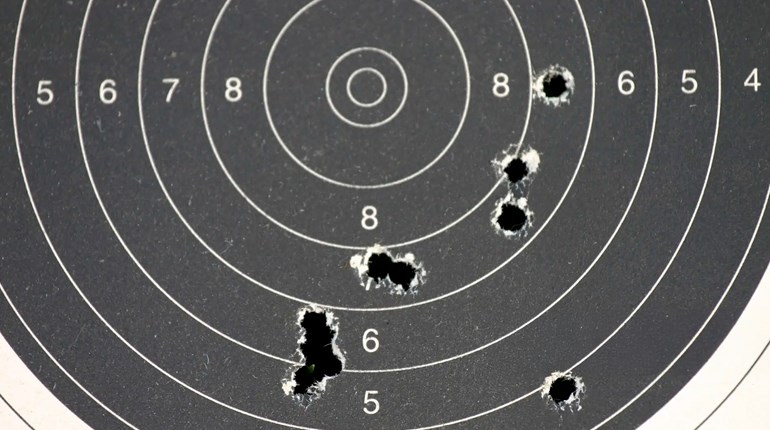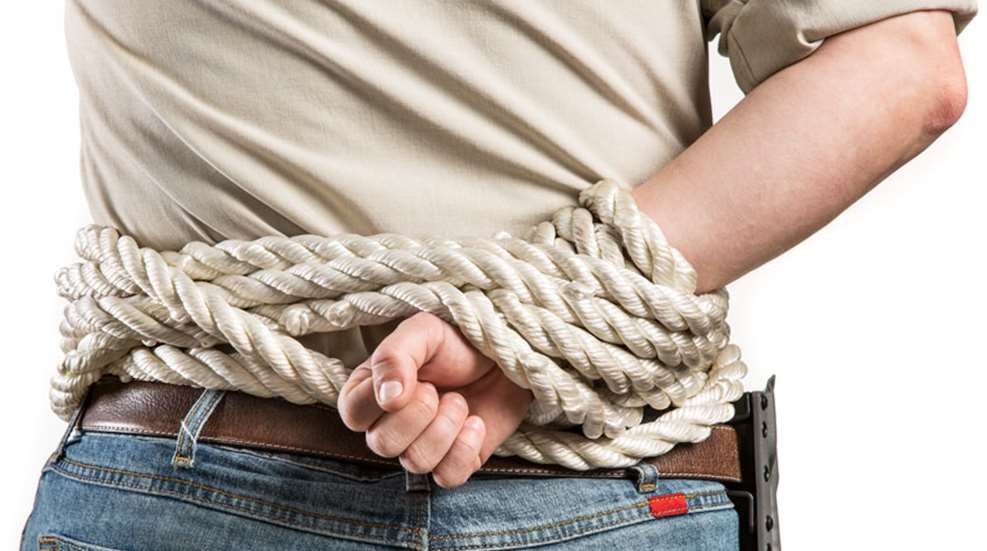
Modern pistolcraft stresses a firm two-handed firing grip on the gun because it’s the best way to deliver fast and accurate fire. The drawback for those involved in a violent self-defense encounter, however, is that two hands may not always remain functionally available.
There is a real possibility of suffering a wound to the gun hand, or the arm behind it, during a shooting confrontation. That can render the strong hand or arm inoperable. One widely held theory for this phenomenon is that, in a gun fight situation, the eyes are naturally drawn to the threat—the gun. With the eyes focused on the gun, the shooter’s gun automatically follows to that threat, and fire is directed there, regardless of which participant is firing.
After-action reports of Officer-Involved Shootings bear this out. In fact, one of the most-studied law enforcement gunfights in modern history—the 1986 FBI Miami shoot out—stands as a classic example.
On April 11, 1986, in the Pinecrest area of Miami, FL, eight FBI agents attempted to arrest two heavily armed and violent bank robbers. The agents were equipped with a mix of handguns and a couple of Remington 870 pump-action, 12-gauge shotguns. The suspects, William Matix and Michael Platt, were armed with a .223 Rem. rifle, shotguns and handguns.
After approximately 145 rounds were fired by all parties, Matix and Platt were dead. Two FBI Agents were also killed and five other agents were wounded, but survived. Of the 10 participants, nine became casualties. The wounds they suffered are revealing.
Prior to receiving their fatal wounds, both Matix and Platt had been hit in their gun-hand arm while shooting at the agents. That severely impeded their ability to deliver accurate fire and undoubtedly saved agent’s lives. One agent took a direct hit to his Smith & Wesson Model 469 pistol while firing at the suspects, disabling the gun and injuring his shooting hand. Another agent was struck on his shooting hand while firing his revolver. A third agent was wounded in his dominant hand while reloading his revolver.
Of the nine casualties, five were hit on either their firearm, their shooting hand or their forearm behind the shooting hand. That’s more than 50 percent of those involved. The gun is the “threat.” The “threat” becomes the target, and the hand or arm holding it can easily receive a bullet. The ability to transition to the weak hand and return accurate fire can be a life-saving skill. But, it is a skill that must be learned and absorbed into the subconscious mind.
Numerous studies have shown that, under extreme stress, an individual will most likely react in the manner they have been trained, or have previously experienced. That’s because the subconscious mind plays a major role when “instinctive responses” are required. However, in order for a proper response to occur there must be proper input for the subconscious to play back. That proper input is created via the repetitive actions we take when correctly performing a task.
Consider this: The first time many of us got behind the wheel of an automobile, it was all very new. We were, quite likely, very conscious of the exact position of our hands on the wheel, the precise amount of pressure to apply to the accelerator, and if something darted into the road in front, or the car ahead suddenly slammed on it’s breaks, we would probably not have found the brake pedal in time to avoid hitting it. Fast forward to today. After time behind the wheel, operating the vehicle becomes subconscious, which frees the conscious mind to deal with what’s going on around it.
Accurately shooting a handgun under stress is little different, and one reason why elite military and law enforcement units routinely include weak-hand practice in their training. If there is no input there will not be the proper subconscious output. This is an area many civilian shooters ignore. They are not providing the input, so in a worst-case scenario, they may not have the output. Here are four simple practice drills that will provide effective input.
Focus Drill
This is sometimes called the “One Hole Drill”, or the “Dot Drill.” Regardless of what it’s called, it becomes “basic training” for the weak hand because it ingrains every shooting fundamental required to deliver an accurate shot.
The drill is shot at 5 yards. The target is a 2-inch circle on a clean, uncluttered background. It starts with the gun in the weak hand and held at a low-ready position. The gun is raised to the target and one round is fired into the circle. It’s then lowered back to low ready, and the drill is repeated for a total of five rounds. The objective is to chew one ragged hole in the target dot.
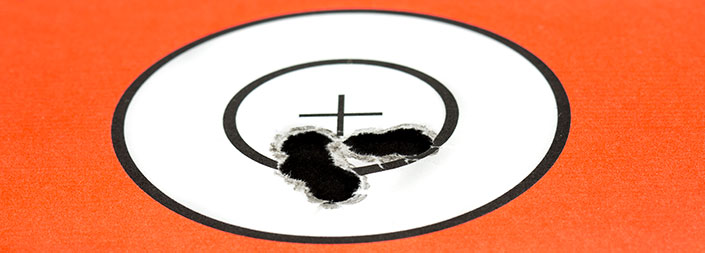
It’s not as easy as it may appear. The target distance is close enough to remove accuracy variables from the handgun, but far enough to require a proper grip, sight picture and trigger press. It will force shooters to execute the basic fundamentals for delivering an accurate one-hand shot—which then become subconscious skill sets built through repetition.
The proper grip and trigger press are stressed. So too is an effective sight picture. Some shooters with a strongly dominant eye on their strong-hand side (right eye for right-handed shooter, or left eye for southpaws) may find that canting the gun inward at about 45 degrees toward their dominant eye helps with correct sight alignment.
Making the proper targets is easy. Shooters can purchase appropriately sized stick-on target dots from a number of manufacturers and slap them on a piece of 8.5x11-inch copy paper. Alternatively, the cardboard tube from a roll of paper towels or toilet tissue measures just about 2 inches—stick one end on a sheet of copy paper and shoot some spray paint into the other end. You now have a target. An inexpensive pack of copy paper and a can of spray paint can make a lifetime supply.
Bill Drill
The Focus Drill develops proper one-hand shooting skills. The “Bill Drill” expands upon that to allow those accurate shots to be delivered in rapid succession. This drill was developed by an action pistol competitor named Bill. Just which Bill is subject to debate, but unimportant. As originally conceived, the shooter faces a single action-pistol target (IDPA or USPSA) at 7 yards with a holstered handgun. The start position is with the wrists held above the shoulder in the “Surrender Position.” At the start signal the shooter draws and fires six rounds into the target as rapidly as they can work the trigger while seeing their sights on target.
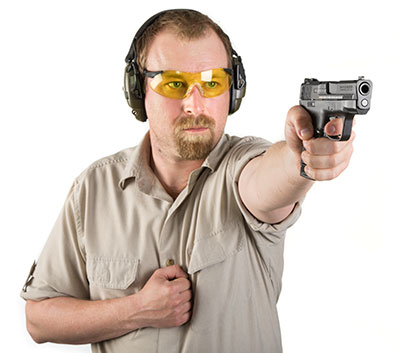
Much of the Bill Drill is not applicable to mastering the weak hand. But, the six rounds rapidly on target (or five rounds if a snubby is your carry choice) certainly are. A modified version will have the shooter facing the 7 yard target with the gun in a low-ready position. The above-mentioned action pistol targets are fine, or a standard silhouette can be used. You want something that more realistically represents the human torso than a bullseye target. At the start signal, bring the gun up and deliver the six rounds (or five), to center mass as rapidly as you can get sights on target. Recoil, obviously, plays a significant role here. One way to help reduce its affects is to imagine the gun as a boxing glove that is delivering a straight jab to the target.
If the gun is in the left hand (right-handed shooter) drive the left foot forward about 15 inches, and push the gun to the target with the body weight forward. Lean aggressively into the “punch.” It’s the most-effective way to deliver rapid one-hand fire at close range and will get the gun back on target more quickly than an upright stance.
A number of instructors teach this technique, and also include bringing the other hand up and into contact with the sternum. This does promote smoother muscle response in the firing hand, better trigger control, and is an aid to rapid one-hand shooting. Whether that is applicable to this “emergency scenario” simulating an injured arm is debatable.
If a shooter drills (programming the subconscious) to bring the non-firing hand up to the chest—but is then unable to do so for real due to the injury that forced them into weak-hand firing to begin with— the subconscious may hesitate, and reply “File Not Found.” For emergency weak-hand practice, it might better to let the non-firing arm hang at the side—just like it probably will be for real.
Transition Drill
Life would be simpler if violence-minded, armed criminals always operated singularly. Unfortunately, they don’t. They will often have equally violent armed thugs with them. The real possibility exists that multiple assailants will have to be addressed in any self-defense situation, so train accordingly.
The above two drills are directed to a single target. That may not reflect the reality of your current situation. The “Transition Drill” programs the mind to deal with multiple threats. The drill involves three “realistic” targets, and there are multiple distances and target spacing that can prove beneficial.

A basic “starter” setup would have three targets placed at 5 yards, set 2 feet apart. From a low-ready position, and the from the aggressive boxing stance, bring the gun up and fire two rounds into each target, smoothly moving the gun between them. The purpose is to move from target one to targets two and three, finding the target, getting the sights on it and pausing the gun long enough to deliver accurate hits. If a five-shot snubby is the chosen tool then do 2-2-1. Target distance can then be increased to the 10 or even 15-yard range, and target spacing can be increased to 6 or 8 feet. The point being to program the mind to move the gun smoothly and accurately between multiple threats.
Speed isn’t the goal, accurate hits are. Swinging rapidly through the targets does little good if they aren’t hit.
Emergency Shift Drill
Nothing says you will begin an armed encounter with your strong-side hand/arm disabled. The chances are greatest that, if it occurs, it will happen sometime during the confrontation. That makes the ability to shift smoothly and quickly between a two-handed firing grip and a weak-hand grip a valuable skill. And, like all skills, it is one that needs to be practiced in order to be input into the subconscious. It’s very difficult for the subconscious mind to do something well that it has never done before. This drill will help.
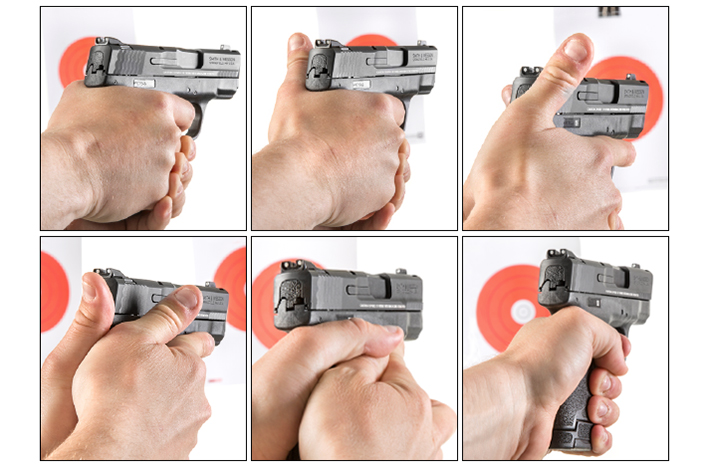
Use the same three-target setup as the Transition Drill. You can start from the low ready, but a better choice is from the holster or other normal carry position. Bring the gun to the first target in a two-handed grip and fire one round onto it. Then shift the gun smoothly to the weak hand, drive the gun to the target, fire one more round onto it, and then engage the remaining targets with two rounds each; or 2-2-1 for a snubby.
The physical shift from a two-hand grip to a weak-hand grip is simple. The support hand relaxes and opens. The strong hand then slightly opens its grip on the gun while pressing it into the weak hand, which then assumes the one-hand firing grip practiced in the above drills. This is best practiced at home, with a for-sure empty gun (with no ammo in the room) or an inert replica before live-fire range work.
Drills to master the weak hand add some time to your range sessions. But, if a worst-case scenario comes to pass, they may prove to be the most valuable training time you spend.















